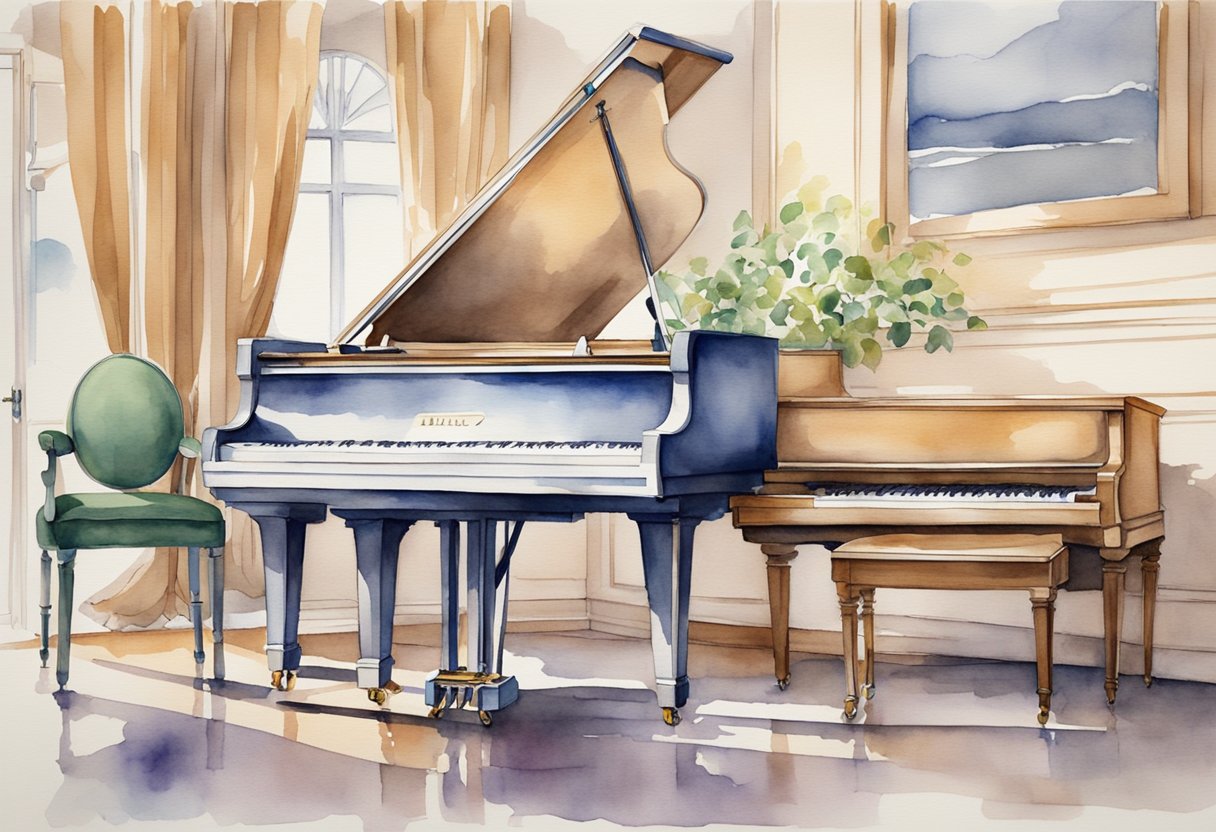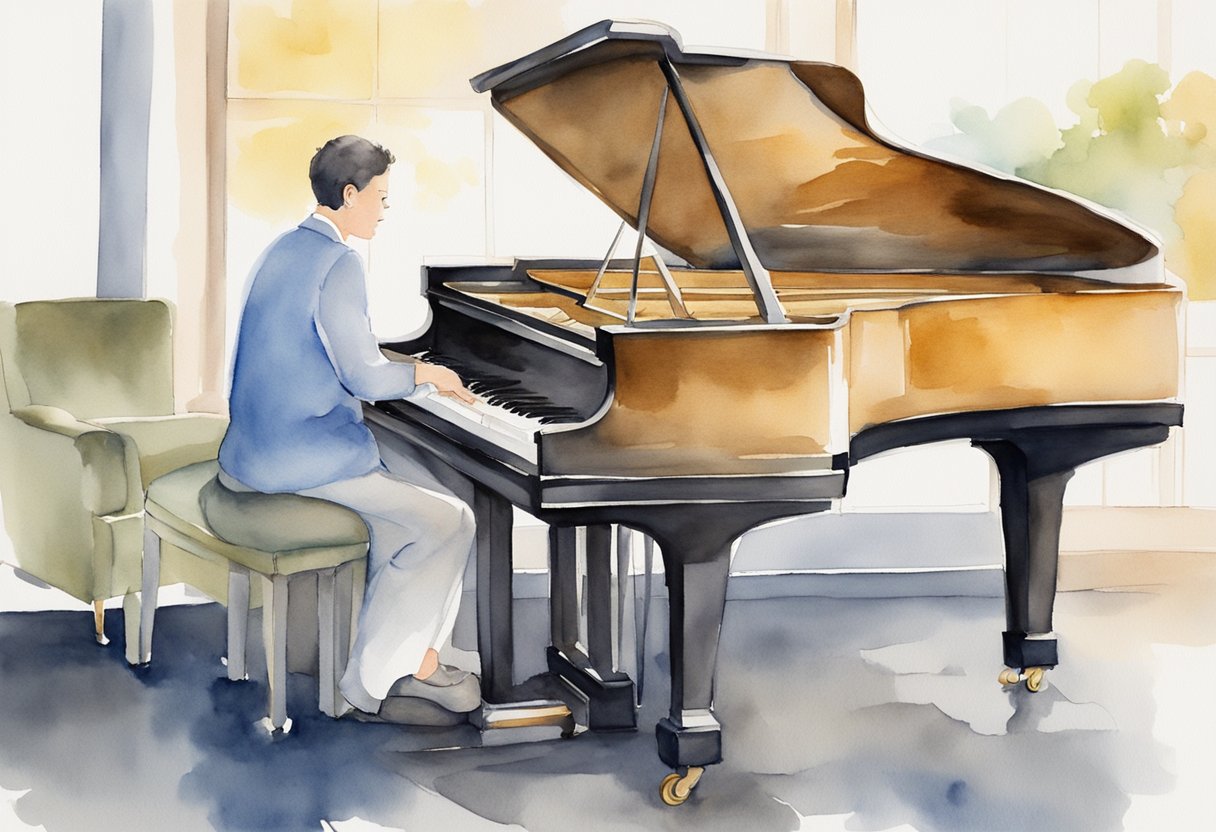As an Amazon Associate I earn from qualifying purchases.
Moving a piano is no small feat, whether you’re rearranging your music room or relocating to a new home. While a furniture dolly can be used to move a piano, it’s critical to understand the intricacies of this process to ensure the safety of both the movers and the instrument.
Pianos are not only heavy but also delicate, so using the correct equipment and techniques is essential.
Want to Learn Piano?Click Here

Professional movers are often equipped with the knowledge and tools necessary to move a piano safely. These specialists know how to navigate the weight distribution and the sensitive nature of the instrument.
However, should you decide to take on the task yourself, it’s important to gather a team of helpers and have the right equipment on hand, like a heavy-duty dolly and moving straps. The process involves careful preparation and understanding of how to secure the piano to the dolly, as well as maneuvering through doorways and onto moving trucks.
As for cost, hiring piano movers might seem like an additional expense compared to a do-it-yourself approach. Still, when you consider the risk of damage to an expensive instrument, or potential injury from moving such a heavy item, the cost can appear quite reasonable.
Preparing Your Piano for the Move

Moving a piano takes careful planning and the right equipment. Your piano is not just a piece of furniture, but a delicate instrument requiring specific handling to maintain its integrity and sound.
Materials and Tools Needed
Firstly, gather all necessary materials and tools for the job:
- Measuring Tape: Used to measure the piano and doorways.
- Heavy-Duty Moving Straps: These will secure the piano during transport.
- Screwdriver: Needed for disassembling parts like the legs and pedals.
- Dolly: Invest in a sturdy furniture dolly or, even better, a specialized piano dolly.
- Moving Blankets: To wrap and protect the piano.
- Packing Tape: To secure the moving blankets.
- Bungee Cords: Optional, for additional security.
It is important to use moving supplies that are robust enough to handle the weight of upright pianos and grand pianos. You might want to compare the cost of renting or buying these materials, as you will find using quality equipment like thick moving blankets or piano boards can range in price but provide invaluable protection.
Securing Loose Components
Before you start moving, make sure to secure any loose components of your piano:
- Legs and Pedals: Use a screwdriver to remove the legs and pedals if possible. This makes the piano more compact and easier to maneuver.
- Wrap the Piano: Cover the piano body with moving blankets to protect it from scratches and bumps. Secure the blankets with packing tape, but ensure it doesn’t touch the piano’s surface as it could leave a sticky residue.
- Bungee Cords: If you’re using a standard furniture dolly, bungee cords can provide an extra layer of stability during the move.
Remember, if you have grand pianos, the process involves more delicate handling and typically more disassembly.
Moving the Piano Safely
When you’re preparing to move a piano, safety is crucial. Pianos are not only expensive and delicate instruments, but they are also heavy and bulky, making them one of the most challenging items to relocate.
Below, I’ll share effective techniques, provide tips for maneuvering through spaces, and advice on how to load your piano for transport — all based on my professional experience.
Techniques for Upright and Grand Pianos
For upright pianos, furniture dollies can be a good option, provided they are sturdy enough to handle the weight. Always use heavy-duty lifting straps for a secure grip and work gloves to protect your hands.
As someone who has moved various types of pianos, I suggest securing the piano to the dolly with tie-down straps. This prevents any unexpected movement that can lead to damage.
When it comes to moving a grand piano, it’s a different ballgame. Piano moving requires the disassembly of the piano lid and pedal lyre. The body should be placed on a piano skid board which is specifically designed for piano moving.
Navigating Through Spaces
Maneuvering a heavy and awkward instrument like a piano through doorways, corners, and possibly up or down stairs requires planning. Measure both the piano and the spaces through which it must pass. For upright pianos, ensure your furniture dolly can handle tight turns, and use furniture straps for additional control.
For moving a grand piano or moving a piano upstairs, more professional equipment, like a metal ramp and custom-built hand trucks, is often necessary. Balance is key; even a slight miscalculation in balancing the weight can lead to accidents or injuries, so take your time and communicate clearly with your helpers.
Loading and Transporting
After safely navigating your piano to the moving vehicle, careful loading is the next step. A pickup truck or moving van with a lift gate is ideal. If not available, a sturdy metal ramp is essential. Once on the vehicle, secure your piano with furniture straps or tie-down straps to keep it from shifting during transport.
Hello & thanks for stopping by! I’m a professional concert pianist and piano instructor. In the United States, I’ve given successful performances in several places including New York, Florida, Connecticut, & New Jersey, I have also performed internationally in Italy and made my Carnegie Hall debut in 2014. I enjoy blogging about the piano, the art of performance, general music, current events and the latest in music production.
